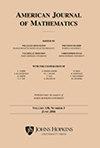接头已拧紧
IF 1.7
1区 数学
Q1 MATHEMATICS
引用次数: 8
摘要
在d维空间中(在任何域上),给定一组直线,关节是由d条不都在超平面上的直线所经过的点。关节问题要求确定由$L$线构成的最大关节数,这是Guth- Katz多项式方法的成功之一。我们证明了在$1+o(1)$因子范围内,与最著名的构造相匹配的关节数的一个新的上界:放置$k$一般超平面,并使用它们的$(d-1)$明智的交叉点来形成$\binom{k}{d}$的线和它们的$d明智的交叉点来形成$\binom{k}{d}$的关节。古斯推测这种构造是最优的。我们的技术建立在张瑞祥的工作基础上,通过多项式方法的扩展证明了多关节猜想。我们建立了一个变分问题来控制多项式在每个关节处的高阶消失。本文章由计算机程序翻译,如有差异,请以英文原文为准。
Joints tightened
In $d$-dimensional space (over any field), given a set of lines, a joint is a point passed through by $d$ lines not all lying in some hyperplane. The joints problem asks to determine the maximum number of joints formed by $L$ lines, and it was one of the successes of the Guth--Katz polynomial method. We prove a new upper bound on the number of joints that matches, up to a $1+o(1)$ factor, the best known construction: place $k$ generic hyperplanes, and use their $(d-1)$-wise intersections to form $\binom{k}{d-1}$ lines and their $d$-wise intersections to form $\binom{k}{d}$ joints. Guth conjectured that this construction is optimal. Our technique builds on the work on Ruixiang Zhang proving the multijoints conjecture via an extension of the polynomial method. We set up a variational problem to control the high order of vanishing of a polynomial at each joint.
求助全文
通过发布文献求助,成功后即可免费获取论文全文。
去求助
来源期刊
CiteScore
3.20
自引率
0.00%
发文量
35
审稿时长
24 months
期刊介绍:
The oldest mathematics journal in the Western Hemisphere in continuous publication, the American Journal of Mathematics ranks as one of the most respected and celebrated journals in its field. Published since 1878, the Journal has earned its reputation by presenting pioneering mathematical papers. It does not specialize, but instead publishes articles of broad appeal covering the major areas of contemporary mathematics. The American Journal of Mathematics is used as a basic reference work in academic libraries, both in the United States and abroad.

 求助内容:
求助内容: 应助结果提醒方式:
应助结果提醒方式:


